©
2004 Jeff Matthews & napoli.com
Io
speriamo che me la cavo
 One
of the most popular books in Italy in recent years was written by an
elementary school teacher, Marcello D'Orta, in the small town of Arzano
near Naples. It was published in 1990 by Arnoldo Mondadori and is entitled
Io speriamo che me la cavo. The title is, one, ungrammatical
Italian and, two, is the heartfelt wish of the schoolchild who wrote
the essay from which the title of the book is taken. It says: "I hope
I pass". The entire book, in fact, is a collection of 60 such essays
written by Mr. D'Orta's charges in the 10 years he was a teacher at
the school. One
of the most popular books in Italy in recent years was written by an
elementary school teacher, Marcello D'Orta, in the small town of Arzano
near Naples. It was published in 1990 by Arnoldo Mondadori and is entitled
Io speriamo che me la cavo. The title is, one, ungrammatical
Italian and, two, is the heartfelt wish of the schoolchild who wrote
the essay from which the title of the book is taken. It says: "I hope
I pass". The entire book, in fact, is a collection of 60 such essays
written by Mr. D'Orta's charges in the 10 years he was a teacher at
the school.
In presenting
the children's essays about, among other things, their favorite films,
their dreams (real and metaphorical), where they would go if they could
travel, their home lives, and what they would do if they were millionaires,
D'Orta says, in the introduction, that he tried to avoid falling into
the trap of "Eduardoism" (in reference to Eduardo de Filippo)—that is, to avoid
an overly staged presentation of every poor schoolchild from Naples
as if that child were a scugnizzo, a street urchin, trying out
for a film. They're not, he says. They're just kids who write with the
simple honesty and insight that children bring to their observations.
The teacher left the ungrammatical title in its original form and, by
and large, left most of the errors in the short essays intact. (In a
translation, of course, that element is almost impossible to render,
and, in what follows, I have not tried to do so.)
One sample:
| Your
teacher talked about Switzerland. Can you summarize the most important
points?
Switzerland
is a small country in Europe that borders on Switzerland, Italy,
Germany, Switzerland and Austria. There are a lot of lakes and
mountains, but there isn't any ocean, especially in Bern.
Switzerland
sells arms to the whole world so they can kill each other, but
Switzerland doesn't ever have even a small war. They build banks
with all their money. But not good banks. The banks are for
bad persons, especially drug addicts. Criminals from Sicily
and China put their money in these banks. The police go and
ask, Whose money is this? and they say I don't know, I'm not
going to tell you, it's none of your damn business, the bank
is closed. But the bank is really open!!
In
Naples, if you get cancer, you die, but in Switzerland you die
later or maybe you live. Because the hospitals are beautiful.
They have carpets, flowers, the stairs are clean and there are
no rats. But you pay a lot of money. Unless you sell stuff on
the black market, you can't afford to go.
Is
this long enough?
|
In 1992,
Italian film director, Lina Wertmüller, made the book into a film
with the same title as the book. The English rendering of the title
is as good as possible, which is not very: "Ciao, Professore."
Actually, the term "ciao" is informal and wouldn't be used by
pupils to a teacher, which fact might make the title not bad since it
is inappropriate language, just like the title of the book. Unfortunately,
most English-speakers who view the film don't know about that subtlety
of Italian and think that "ciao" means, simply, "Hello," which
it doesn't. The film stars the great comic Paolo Villaggio as the teacher
and centers on his character, a teacher from the north of Italy who
winds up, through a computer error, assigned to just such a small school
in the Neapolitan outback. Of course, he can barely understand the native
Neapolitan dialect of his pupils. His learning to understand them and
their problems at home (descriptions of which are taken direcly from
the book), is the charm of the film.
Donizetti,
Gaetano
(1797-1848)
With
Rossini and Bellini,
Donizetti is one of the important names in early 19th-century Italian
opera and a founder of Italian Romanticism. He was born in Bergamo.
After initial musical studies, he was commissioned to write two short
works that were performed in Venice in 1818. He also wrote sacred
music and several string quartets. One work, Zoraid di Granata,
composed in 1821 and performed in Rome caught the ear of Domenico
Barbaja, Neapolitan impresario, who invited him to compose for Naples,
a city where Rossini was already active and thriving and where Bellini
was just starting out.
Donizetti
moved to Naples in 1822 and stayed for 16 years. Today, a plaque on
his home in Naples quite ignores his operas and reminds us that he was
the composer of Ti voglio bene assaje, the winner in 1835 of
the first Festival of Piedigrotta for the Neapolitan
popular song. The piece is still a mainstay of that repertoire.
It is typical of his approach to his work, in general, that he would
write music at the drop of a hat —early comic operas, later
serious melodrama, and, here, even popular songs. (Interestingly, as
the illustration shows, he was often in such a hurry to write music
that he availed himself of his rather unusual form of ambidexterity
--writing with both hands at the same time!)
He composed
La zingara in 1822 and at least 5 other operas before 1830, including
works for La Scala in Milan. He spent a year in Palermo in 1826 and
then returned to Naples where he became the director of the Teatro
Nuovo. He became the director of the Royal Theaters in Naples in
1828 and held that post for 10 years.
Donizetti
was a prolific and fast composer, turning out 30 operas before he can
be said to have "made it" with Anna Bolena in 1830. A partial
list of his more well-known works, still very much part of the operatic
repertoire, includes Elisir d'Amore (1832); Lucrezia Borgia
(1833); Lucia di Lammermoor (1835); La figlia del regimento
(1840); and Don Pasquale (1843). Much of his work in Naples in
the 1830s was subject to typical censorship by the absolutist Bourbon monarchy, particularly allergic to undue
violence or allusions to royalty and unhappy endings—particularly
restrictive in an art form that was well on its way to a reputation
for thriving on tragedy. Lucrezia Borgia was, in fact, banned
in Naples. He left Naples in 1838, at least partly due to the restrictive
atmosphere he was forced to work in. He moved to Paris and then to Vienna
where he became court composer to the Austrian emperor. By the early
1840s, Donizetti was seriously ill with syphilis. He moved back to his
hometown of Bergamo in 1848 and died there.
Musically,
like other composers of his generation, he was a product of the influence
of the Neapolitan comic opera. Yet,
Romanticism had arrived and there is no doubt that Donizetti is one
of its founders, particularly when the hallmarks of Romanticism —human
passion and struggle—were freed from the confines of censorship.
He had what would become the Romantic flair for slow, plaintive melody,
typified, say, by "Una furtiva lacrima" from Elisir d'Amore (still
one of the best-loved of all operatic arias), yet, untypically, never
at the expense of the text. He was known for bickering with his librettists
over their choice of words. He had somewhat of a professional rivalry
with his contemporary, Bellini, and, perhaps, in historical terms, can
also be said to have overshadowed the great Italian influence of the
early 1800s, Rossini, who became less and less active as the century
became more and more Romantic.
With historical
hindsight, it is interesting to read music reviews from, say, 1850,
that wondered whether the young upstart, Verdi, would ever amount to
another Donizetti. The year of Donizetti's death, 1848, was also the
year of the great wave of revolutions that swept Europe, demanding a
corresponding artistic expression more emotional and turbulent than
even Donizetti could ever have imagined.
Capri
(4)
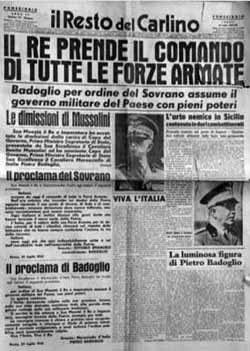 I
called up Herman the other day to see if had attended last week’s
ceremony commemorating the Anglo-American invasion at Salerno. It took
place 60 years ago and Herman, who is now 87 years old, was part of
it. He told me that he hadn’t attended, though he had spoken with
some members of the US 36th infantry who had stopped by to say hello
to him in Sorrento. The ceremony in Salerno was marked by some counter-demonstrations
by those who feel that remembering anything at all to do with war and
violence is a bad thing, even when it’s on behalf of the good
guys. I
called up Herman the other day to see if had attended last week’s
ceremony commemorating the Anglo-American invasion at Salerno. It took
place 60 years ago and Herman, who is now 87 years old, was part of
it. He told me that he hadn’t attended, though he had spoken with
some members of the US 36th infantry who had stopped by to say hello
to him in Sorrento. The ceremony in Salerno was marked by some counter-demonstrations
by those who feel that remembering anything at all to do with war and
violence is a bad thing, even when it’s on behalf of the good
guys.
September
1943 was turbulent and confusing for Italians. The nation surrendered
to the Allies on September 8, at which point Pietro Badoglio, who had
succeeded the deposed Mussolini as head-of-state in July 1943 (newspaper
headline photo), declared that the war would now continue on the side
of the Allies and against the Germans and Italian Fascists. That plunged
Italy into a civil war.
The armistice
of September 8 provided a strange episode—amusing in hindsight—having
to do with the Isle of Capri. There were about 2500 members of the Italian
Armed Forces on Capri at the time of the armistice. Obviously, they
were now all part of the Allied command at war with their old allies,
the Germans.
Part of
the terms of the armistice required the Italian naval contingent on
Capri to move to Palermo, in Sicily. The Italian commander was unable
to comply with the order because there simply wasn’t enough fuel
left to run the ships that far. He sent a motorboat over to the Gulf
of Salerno to advise the Allied commander of the situation; that is,
the Italian forces on Capri weren’t making any sort of a Fascist
last stand on Capri, nor were they refusing to surrender. They just
had no fuel for the ships.
Accordingly,
on September 12, an Allied ship showed up at Capri to check out the
situation. The Allied commander then—for reasons that are as obscure
as they are silly—demanded a separate “unconditional surrender…
[from] the Commanding Officer of the Axis Armed Forces on the Islands
[sic] of Capri.” (The Allied commander may have been counting
the Faraglioni, those two beautiful rocks 100 yards off shore
as separate islands.)
In a true
Laurel and Hardy finish to the episode, the surrender document—written
in both English and Italian—was signed improperly. The Allied
officer signed on the wrong side of the page, leaving the Italian no
choice but to sign in the name of General Eisenhower.
Soccer
(5)
 Since
I last mentioned the topic (here), someone
has managed to patch up the disastrous situation in the Italian soccer
leagues. Naples was on the verge of being relegated to the C-League
on the basis of a legal decision about the validity of a signature on
a document. That decision was appealed and overturned, which left some
people happy, others unhappy, and almost everyone confused. No one seemed
to know which teams would go down to the C League and which would be
promoted to the B League. As a result of that confusion, several of
the B League teams refused to play their opening matches two weeks ago. Since
I last mentioned the topic (here), someone
has managed to patch up the disastrous situation in the Italian soccer
leagues. Naples was on the verge of being relegated to the C-League
on the basis of a legal decision about the validity of a signature on
a document. That decision was appealed and overturned, which left some
people happy, others unhappy, and almost everyone confused. No one seemed
to know which teams would go down to the C League and which would be
promoted to the B League. As a result of that confusion, several of
the B League teams refused to play their opening matches two weeks ago.
The situation
was resolved by trying to make everyone happy; that is, no one would
go down to the C League—the B League would just be expanded
to include all the would-have-been demotees. So far, so good. Alas,
the teams that didn't play the first week have started out somewhat
in the hole in the league standings. The scoring rules give a team 3
points for a victory, 1 for a draw and 0 for a loss. The fine print
also reads "loss of a point for a forfeit"—that is, refusing
to play in the first place. Thus, some teams started out this season
with a minus 1. So maybe not everyone was happy, but I did say, "patch
up".
Pizza
(3)
 The
scene was the Mostra d'Oltremare,
the Overseas Fair Grounds in Naples. Since last I wrote about it, at
least the arena, the spacious outdoor theater, has been renovated and
is once again ready to host large-scale productions, maybe even Aida,
just like in the good old days. The
scene was the Mostra d'Oltremare,
the Overseas Fair Grounds in Naples. Since last I wrote about it, at
least the arena, the spacious outdoor theater, has been renovated and
is once again ready to host large-scale productions, maybe even Aida,
just like in the good old days.
The event
in question last week was a bit less ambitious, but still worthy of
mention. It was Pizzafest 2003, a pizza cook-off to choose—and
what better judges than Neapolitans? —the world’s greatest
pizzaiolo, or pizza chef.
Without
further ado, may I have the envelope, please. Ahem. The third-place
winner is Luigi Picariello from Naples. (Ho-hum.) The second-place winner
is Antonio Langella from Naples. (Please hold your applause and ho-hums.)
And the world’s greatest pizza chef is—Makato Inishi from
Japan! (I told you to hold the ho-hums.)
That’s
right. In a fair cook-off, the 23-year-old Japanese young man beat all
comers. He came to Naples two years ago for the express purpose of learning
the art of pizza cooking, and seems to have done rather well. I don’t
know if he is the gentleman I mentioned elsewhere,
one sent here with an interpreter to learn the pizza trade. It wouldn’t
surprise me, but on the other hand, I have heard that there are at least
a few such visitors from Japan in Naples. In any event, there were no
sour grapes (not an authentic topping, anyway) on the part of the Neapolitans.
They seemed happy that they had taught Makato so well.
This is
perverse, I know, but somehow I am reminded of the scene in Doctor
Strangelove where Sterling Haden, as deranged general Jack D. Ripper,
asks RAF officer Mandrake (played by Peter Sellers) if he had been tortured
by the Japanese when he was their prisoner in World War II.
“Yes,”
says Mandrake. “I don’t understand. They make such bloody
good cameras.”
San Gennaro
(3)
Silver
bust of S. Gennaro donated by Charles II of Anjou in 1305, in the Naples
cathedral.
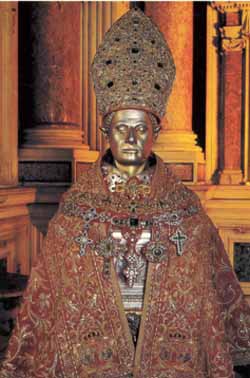 Yesterday,
of course, was San Gennaro, the feast
day of the patron saint of Naples. On this day, the faithful anxiously
await the miraculous liquefaction of a vial of the saint’s clotted
blood. This “Miracle of San Gennaro,” if it comes to pass,
is regarded as a good omen for the city of Naples in the year to come.
Yesterday, the faithful who waited in the Cathedral of Naples, where
the ceremony surrounding the event takes place, were rewarded early
in the day. At 9.57 a.m. Cardinal Michele Giordano held up the vial
and announced that the miracle had, indeed, transpired. Yesterday,
of course, was San Gennaro, the feast
day of the patron saint of Naples. On this day, the faithful anxiously
await the miraculous liquefaction of a vial of the saint’s clotted
blood. This “Miracle of San Gennaro,” if it comes to pass,
is regarded as a good omen for the city of Naples in the year to come.
Yesterday, the faithful who waited in the Cathedral of Naples, where
the ceremony surrounding the event takes place, were rewarded early
in the day. At 9.57 a.m. Cardinal Michele Giordano held up the vial
and announced that the miracle had, indeed, transpired.
One newspaper
headline reported “A lightning miracle in a fortified cathedral,”
referring to the security measures in place to avoid potential disruption
by a nearby demonstration of the unemployed, all of whom would have
liked to get in and bend the ear of the mayor of Naples, Rosa Russo
Iervolino, or the president of the Campania Region of Italy, Antonio
Bassolino, both of whom were in attendance.
A special
section of the daily, il Mattino, dedicated a series of short
articles to various aspects of the phenomenon of San Gennaro, including
items perhaps not generally known to Neapolitans, themselves. For example,
San Gennaro was made the patron saint of Naples in 472 a.d. during an
eruption of Mt. Vesuvius as powerful as the one that had destroyed Pompeii
400 years earlier. Naples had always had a history—even before
the advent of Christianity—of making appeals to the gods. Naples
had so many temples to Greek and Roman gods that Quintilia, a figure
in the Satyricon (written in 60 a.d.) says: “We have so
many gods that they’re easier to find than people.” San
Gennaro, himself, was preceded as patron saint of Naples by, among others,
Saint Agrippino, but when the eruption hit and thousands of Neapolitans
crowded into the catacombs where San Gennaro was entombed, and beseeched
him to save them from the impending disaster, he—well, he apparently
did. The eruption stopped and Gennaro has been the patron saint ever
since.
With one
exception. He expressed approval of the Neapolitan Republic in 1799
by performing his miracle at the behest of the French commander of the
forces supporting the Republican cause. In retaliation, the Army of
the Holy Faith, the Royalist Neapolitans, later retook the kingdom under
the banner of Saint Anthony. But that was a temporary lapse.
The first
mention of the miracle of blood liquefaction is from 1389. The paper
reports on attempts of skeptics to fabricate (using 1389 technology)
a liquid that looks like solid blood and will liquefy when shaken (yes,
it can be done). Also, there is an account of the adventures of Giuseppe
Navarra, the so-called King of Poggioreale, a hustling junk merchant,
who in 1947 took it upon himself to go to Rome and bring back the treasures
of San Gennaro from the Vatican, where they had been moved for safekeeping
during World War II.
These treasures,
by the way, include a collection of gold, silver, and diamond artifacts
of incalculable value. The will all be on display shortly in a brand
new museum of The Treasures of San Gennaro to be inaugurated later this
year by the President of Italy, Carlo Azeglio Ciampi.
Elsewhere,
in a book entitled Napoli Antica by Vincenzo Regina (pub. Newton
and Compton, Rome, 1994), I came across a strange tale of San Gennaro.
It used to be the custom for a “relic” of the saint (in
this case, part of the skull) to be transported from the Cathedral to
a local seggio, a seat of local government within the city—a small
town hall, as it were—on one of the days when the miracle was
supposed to occur (there are a few other days besides September 19.)
At day’s end, the relic would be duly transported back to its
place in the cathedral. Representatives of the local seggio always provided
transportation. They would show up at the Cathedral, pick up the relic,
take it away and bring it back. In 1646, however, the good folks in
the Cathedral refused to hand over the relic and insisted on doing the
moving, themselves. During the procession, they were assaulted by the
locals and a good-sized fistfight broke out over who had the authority
to escort San Gennaro’s skull.
Normans,
the
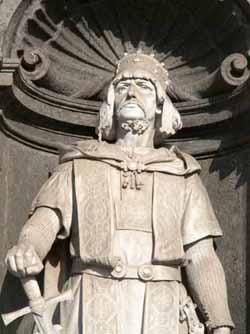 The
Other Norman Conquest The
Other Norman Conquest
By the
year 1000 Italy south of Rome was a hodge-podge of Lombard duchies plus
a number of small city-states such as Naples as well as various Byzantine
provinces; there was also a massive Arab presence on Sicily and the
southern mainland. Into this already complicated setting rode the Normans,
only a few generations after wading ashore in France as the justifiably
feared warrior-race, the Vikings.
Now, the
nicest thing ever said about the Vikings was that, yes, they were ferocious,
cunning and absolutely ruthless—completely given to pillaging
and plundering—but not because they liked it! It was because
they realized that ruthless pillaging and plundering was the most efficient
way to get what they wanted: namely, the property and possessions of
others.
If the
Vikings were only half as nasty as their reputation, it is little wonder
that within 150 years of their first raids on Britain and the continent
they had maneuvered the French king, Charles the Simple into the wise
move of ceding to them in 911 the land in the north of France which
would become known as Normandy, named for them, the Northmen or Normans.
The real wonder of it all is that they decided to settle down, and even
more wondrous was that in a few generations' time, all their fire and
rage would be diluted by southern climes, and their empire in southern
Italy would be known for its tolerance, culture and laid-back way of
life. But that is precisely what happened.
If you
stand in front of the royal palace in
Naples and look at the statues of the rulers of the city, Roger II,
the Norman, is the first one (photo, above). He is the monarch who represents
the beginning of modern history in Naples. He was the beginning of what
might be called a European dimension in southern Italy.
The feudal
redistribution of land in Normandy had meant that a number of young
Norman knights wound up with nothing, so they sought their fortunes
elsewhere. By the early eleventh century, bands of them were already
wandering around this area, fighting for anyone who would pay them --Lombards,
Byzantines, the Papacy, the Dukes of Salerno, Capua or Naples. In return
for helping the Neapolitan Duke, Sergio IV, in 1029, they were given
the hill-fortress in Aversa with its dependencies, and that area soon
became a jumping off point for Norman adventurers who wished to take
part in the struggles going on for control of the south. In the middle
of the eleventh century they were fighting for and against everyone,
managing to take over piecemeal much of what had been Lombard land.
By 1090 they had taken Sicily from the Arabs.
Robert
of Hauteville arrived in 1047. He was described as very tall with eyes
that all but emitted sparks and a voice that put his enemies to flight.
His ambition and lust for adventure are said to have been an inspiration
to William ("the Conqueror") back home and so, at least second hand,
he may have played a part in the invasion of Britain in 1066. [The Naples
Web Log entry about Robert's wife, Sichelgaita,
is also relevant.]
The Papacy,
originally glad to have Norman help against the Byzantines and Lombards,
realized that the Norman tail was now wagging the Papal dog. Normans
were raiding monasteries in Italy with as much abandon as had their
Viking grandfathers a few generations before in Britain and France.
The Normans consolidated their gains in a victory over the combined
Papal forces of Lombards, Italians (from the Papal States) and German
mercenaries at Benevento in 1054. The Pope as well as the Western Empire
were forced to ratify Norman gains. It was a brilliant move by the Normans:
they now pledged allegiance to the Church, in return for which, of course,
the Papacy consecrated the Norman Empire in the South, now virtually
all in Norman hands, anyway.
By 1060
there were three separate Norman holdings: Aversa, Capua and Apulia,
the last of which was the most important, because it was from there
that the Normans, under Roger I, (Robert's brother) went on to take
over Sicily and, by default, all Norman holdings in the South.
Shortly
after William the Conqueror had successfully invaded Britain, Robert,
who saw himself as eventual lord of the whole Mediterranean went on
to try and mop up the entire Byzantine Empire in Greece, and failed.
His less ambitious sibling, Roger, stayed on in Sicily. Roger's third
son became Roger II, and was crowned King of Sicily in 1130.
Roger II
marched north in a campaign to unify Sicily with the southern Italian
mainland. He entered Naples in September 1140. Story has it that he
got on the good side of his Neapolitan subjects immediately by calling
them together and asking them how long the city wall was. No one knew,
so he personally marched it off at 2,373 paces and announced that he
was going to enlarge it for the good of Naples and it citizens.
The city
thus lost its independence, but gained a king who called himself Rex
Siciliae et Italiae, and membership in an ambitious empire, one
with designs on North Africa and the Eastern Mediterranean. The capital
was Palermo, one of the richest and most opulent cities of the day,
efficiently and benevolently ruled by a mixed aristo-burocracy of Greeks,
Sicilians and Arabs. It was a place where your god, language and race
took a back seat to whether or not you could get the job done. For a
brief period, the overused phrase "Golden Age" truly applied to this
empire, as the collective voices of centuries of Mediterranean cultures
joined together almost as if to announce the coming of the Renaissance
Roger died
in Palermo in 1154, and a few years later the Norman Kingdom of the
South fizzled out because of lack of male issue. One of Roger's granddaughters
had married the son of the German emperor Barbarossa. Their child would
become Frederick the II and, thus, the
Kingdom of Two Sicilies would pass to German rule.
It was
a strange end for the Normans. In the South they were victims—fortunate
ones, perhaps—of their own flexibility. They started out
as almost caricatures of themselves: ferocious, aggressive, asking no
quarter and certainly giving none. They wound up as a blend of cultures,
languages and faiths, a society apparently ruled by "an aristocracy
of talent" (to use Thomas Jefferson's choice phrase) In hindsight, coming
as it did on the eve of that atrocity known as The Crusades, their rule
here seems to have been one of the last great periods of understanding
and tolerance in European history, one in which there was a fortunate
and rare reversal of the roles described by Yeats: This time it was
not "the worst," but "the best," who were "full of passionate intensity".
America's
Cup (2), urbanology (7)
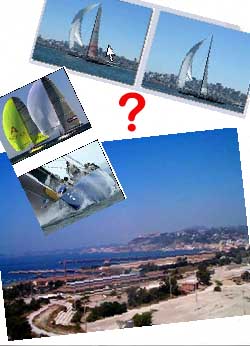 The
plans to “deindustrialize” the Bay of Pozzuoli are ambitious.
The area includes the town of Bagnoli and extends west along the coast
through Pozzuoli, itself, and on to the end of the bay at Cape Miseno.
The long-term plan, one assumes, is to try to resurrect the natural
beauty of the area with an eye for attracting some of the considerable
money generated by the tourist trade elsewhere in the Gulf of Naples—that
is, Naples, the Sorrentine peninsula, and the islands of Capri and Ischia. The
plans to “deindustrialize” the Bay of Pozzuoli are ambitious.
The area includes the town of Bagnoli and extends west along the coast
through Pozzuoli, itself, and on to the end of the bay at Cape Miseno.
The long-term plan, one assumes, is to try to resurrect the natural
beauty of the area with an eye for attracting some of the considerable
money generated by the tourist trade elsewhere in the Gulf of Naples—that
is, Naples, the Sorrentine peninsula, and the islands of Capri and Ischia.
It’s
a tall order, but they have started. This week, they started the end-stage
demolition of the remains of the old Italsider steel mill, for many
decades a thriving enterprise as well as an unsightly blob of industrial
blight in Bagnoli. As well, the Sofer plant in Pozzuoli has been closed.
It was one of the oldest industrial concerns in the Naples area, having
been built 120 years ago, not too long after the unification of Italy.
For over a century it turned out railway coaches and engines.
These few
steps into the post-industrial age are independent of—but somehow
connected psychologically with—another ambitious project: attracting
the next America’s Cup regatta to the waters of Bagnoli, off the
tiny island of Nisida. Scarcely a day goes by without an update in the
papers. Within the next few months, the Swiss defenders of the Cup will
make their decision as to where they wish to defend their title, and
Naples, it seems, stands a reasonable chance of being selected. Money
has been found, marine architects hired, plans for the new harbor are
on the boards. The design presents what the papers have been calling
a “canal harbor”; that is, using the large area that used
to contain the facilities of the Italsider steel mill, a long rectangle
will be cut in from the sea, one end of which is, obviously, the outlet
to the bay, with the perimeter of the other three sides providing mooring
for boats.
It will
be a shot in the arm for the area if the Swiss choose these waters and
that kind of ambitious boat harbor is built. Even if Naples loses out
in the America’s Cup lottery, however, the other plans—the
ones to turn the area into the kind of place that people will actually
want to visit and enjoy—will continue.
Metropolitana
(4)
 There
is a famous postcard of the Bay of Naples seen from the Posillipo hill
above Mergellina. It’s the classic view: the waters in front of
the Villa Comunale and the seaside road, via Caracciolo,
the Castel dell’Ovo, and the double peaks of Mt. Vesuvius
and its companion, Mt. Somma, in the background with the beginnings
of the Sorrentine peninsula spreading to the south. The photo is usually
taken such that there is a famous, solitary Mediterranean pine tree
in the foreground. There
is a famous postcard of the Bay of Naples seen from the Posillipo hill
above Mergellina. It’s the classic view: the waters in front of
the Villa Comunale and the seaside road, via Caracciolo,
the Castel dell’Ovo, and the double peaks of Mt. Vesuvius
and its companion, Mt. Somma, in the background with the beginnings
of the Sorrentine peninsula spreading to the south. The photo is usually
taken such that there is a famous, solitary Mediterranean pine tree
in the foreground.
We used
to joke that the reason they used that same tree all the time was that
it was the only one left in Naples. That is, of course, an exaggeration,
since, as I have pointed out elsewhere, there are a number of large
parks in Naples: the Villa Comunale, the Floridiana, the
grounds of the Capodimonte museum, and the vineyards of San
Martino. Those parks don’t change the fact, however, that
your average neighborhood trees, the ones that line the street in front
of your house, little by little, over the years, can’t help but
lose the battle with encroaching, egregious overbuilding. We need a
garage—those trees go. An extra parking space or two?—chop,
chop. (Forget the downright forests sacrificed to illegally built, entire
blocks of flats.)
Thus, I
am unhappy and suspicious when I read that 60 (!) trees have been chopped
down in Fuori Grotta to accommodate construction sites for the new underground
train line coming in from the area of the new university and San Paolo
football stadium. “New underground train line” is,
of course, ridiculous. That is the train that was supposed to be up
and running in 1990 for the World Cup soccer matches (see here). Now that incompetence and bribery have
been relegated to the rubbish heap of history, the train line (officially
to be known as Line #6) will be finished and joined to the main lines
of the metropolitana in Naples. This has meant performing quintuple
by-pass surgery on the one main road, viale Augusto, that leads
through that section of town, creating a labyrinth of one-way detours
to get from one end of the road to the other, one mile away. Of the
30 palm trees that were there a few days ago, 8 are still there; the
other 22 have been moved, but shall be returned. Sixty pines, however
got the axe. The city promises that they will replaced by 94 new ones
when the construction is finished. City promises—well, they are
what they are.
Bellini
(Piazza) (2)
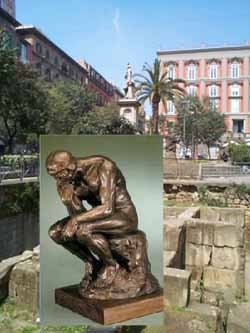 Persons
described in the morning paper as “Neapolitan intellectuals”
have written an open letter to the city administration protesting the
proposed renovation of Piazza Bellini ( also
see separate entry). Persons
described in the morning paper as “Neapolitan intellectuals”
have written an open letter to the city administration protesting the
proposed renovation of Piazza Bellini ( also
see separate entry).
I am always
amused by the definition of people as “intellectuals,” as
opposed to just plain “intelligent” or even “very
intelligent”. It makes you wonder if “intellectual”
is a profession or, at least, an official position. Maybe they have
a guild, union or club you can join where you get an ID card or decoder
ring and learn a secret handshake—all contingent upon your oath
that when others go bowling with the boys on Wednesdays, you go deconstruct
Kierkegaard and smoke French cigarettes.
Whatever
the case, this time they are right. The charm of Piazza Bellini is that
it is cockeyed and a bit seedy. Is it dirty? Yes, it can be, but that
condition, says the letter, won’t be helped by getting rid of
the irregular, bleacher-type irregularities that make you step up once
or twice and then down again as you cross the square. If you level the
square and turn it into the planned black-and-white checkerboard design
with a shallow platter-shaped fountain in the middle (with no water!),
put in a single central palm tree (after getting rid of all the other
trees), and even out the staggered entrances to the “literary”
cafes that open onto one side of the square—if you do all that,
you will then have a useless and inappropriate bit of urban surgery
that will have cost the city 700 thousand euros—and it will still
get dirty.
Why not
leave the square the way it is and just clean it regularly? Also, clean
the statue of the square’s eponym, Vincenzo Bellini. The statue
is the target of graffiti vandals and has been so abused over the years,
that the four secondary busts of women from the composer’s operas
have had to be removed from the niches that surround the base of the
central figure of Bellini, himself. (In the course of the removal and
transfer to God knows where, one of the busts disappeared.
Modernization
is not the answer to everything, says the letter. The city modernized
the Villa Comunale and no one likes it (what happened to all the trees?);
the city modernized Piazza Dante after the recent subway construction
and turned it into wide-open flat space with no shade and very few places
to sit. And so forth and so on. Spend the money on regular maintenance
and Piazza Bellini will be just fine.
Street
life (descriptions)
In another
entry I refer to the “cascade of chaos” in the
pages of Harper’s Weekly in a description of Neapolitan
street life from the mid-1800s. (A short excerpt, as a reminder):
| …water-sellers
bawling iced water; pious minstrels playing doleful bagpipes under
a statue of the virgin; Sicilian girls dancing the tarantella
with uncommon vigor; friars roaring that they only want a gran
more to save a soul from hell; boys fighting for watermelons;
exchange tables loaded with copper; lemonade-stands mounted by
triumphal arches, bedizened with gold paper and wreathes of flowers;
macaroni-dealers ladling huge masses of the smoking delicacy out
of cauldrons, and beseeching the crowd not to let it cool; more
monks tinkling little bells, and knocking Punch and the conjuror
over as they hurry past with a dead man… |
I enjoy
comparing that with similar passages from other sources—famous
ones—from around the same time. Here is a short passage from Pictures
of Italy by Charles Dickens: (Click
here for the entire excerpt.)
| …for
all Naples would seem to be out of doors, and tearing to and fro
in carriages. Some of these, the common Vetturino vehicles, are
drawn by three horses abreast, decked with smart trappings and
great abundance of brazen ornament, and always going very fast.
Not that their loads are light; for the smallest of them has at
least six people inside, four in front, four or five more hanging
on behind, and two or three more, in a net or bag below the axle-tree,
where they lie half-suffocated with mud and dust. Exhibitors of
Punch, buffo singers with guitars, reciters of poetry, reciters
of stories, a row of cheap exhibitions with clowns and showmen,
drums, and trumpets, painted cloths representing the wonders within,
and admiring crowds assembled without, assist the whirl and bustle.
Ragged lazzaroni lie asleep in doorways, archways, and kennels;
the gentry, gaily dressed, are dashing up and down in carriages
on the Chiaji, or walking in the Public Gardens; and quiet letter-writers,
perched behind their little desks and inkstands under the Portico
of the Great Theatre of San Carlo, in the public street, are waiting
for clients... |
And one
from The Innocents Abroad by Mark Twain: (Click here for the entire excerpt.)
| …I
will observe here, in passing, that the contrasts between opulence
and poverty, and magnificence and misery, are more frequent and
more striking in Naples than in Paris even. One must go to the
Bois de Boulogne to see fashionable dressing, splendid equipages,
and stunning liveries, and to the Faubourg St. An-toine to see
vice, misery, hunger, rags, dirt -- but in the thoroughfares of
Naples these things are all mixed together. Naked boys of nine
years and the fancy-dressed children of luxury; shreds and tatters,
and brilliant uniforms; jackass carts and state carriages; beggars,
princes, and bishops, jostle each other in every street.
At
six o’clock every evening, all Naples turns out to drive
on the Riviera di Chiaja (whatever that may mean); and for two
hours one may stand there and see the motliest and the worst-mixed
procession go by that ever eyes beheld. Princes (there are more
princes than policemen in Naples - the city is infested with
them) - princes who live up seven flights of stairs and don’t
own any principalities, will keep a carriage and go hungry;
and clerks, mechanics, milliners, and strumpets will go without
their dinners and squander the money on a hack-ride in the Chiaja;
the rag-tag and rubbish of the city stack themselves up, to
the number of twenty or thirty, on a rickety little go-cart
hauled by a donkey not much bigger than a cat, and they drive
in the Chiaja; dukes and bankers, in sumptuous carriages and
with gorgeous drivers and footmen, turn out, also, and so the
furious procession goes. For two hours rank and wealth, and
obscurity and poverty, clatter along side by side in the wild
procession, and then go home serene, happy, covered with glory!…
|
Today,
it is still possible to catch a carriage ride if you are a tourist and
want to pay whatever exorbitant fare they charge for clip-clopping along
the seaside on via Caracciolo—a street that did not exist
in the mid-1800s; however, some of the romance goes out of the experience
amid the din of cars, motor-scooters, and all-around roar of technology.
It’s a tough call, but on a bad day in modern Naples, those descriptions
from the 1800s sometimes seem almost bucolic.
Anticaglia,
via—
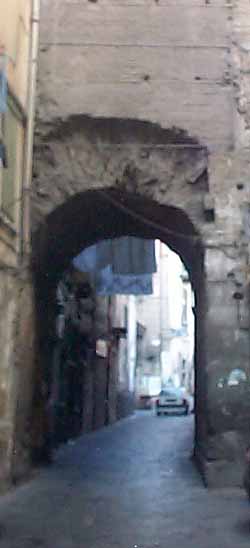 One
of most fascinating things about a palimpsest would be to use some of
that new-fangled multispectral imaging and be able to see what was actually
written on the layers below the surface. Who knows, you might wind up
in ancient Greece. (I understand that is precisely what has happened
at a museum in Baltimore, where they have found Archimedes’ Theory
of Floating Bodies floating well below the surface of some medieval
scribbling. One
of most fascinating things about a palimpsest would be to use some of
that new-fangled multispectral imaging and be able to see what was actually
written on the layers below the surface. Who knows, you might wind up
in ancient Greece. (I understand that is precisely what has happened
at a museum in Baltimore, where they have found Archimedes’ Theory
of Floating Bodies floating well below the surface of some medieval
scribbling.
Archaeologically
in Naples, there is no doubt a palimpsest phenomenon at work. All you
have to do is dig a station for the metro almost anywhere near sea level
in the city and you uncover, first, some Spanish walls and, sooner or
later, bits and pieces of ancient Rome and Greece. It happens all the
time.
Those without
personal steam shovels may have to settle, however, for a kind of “horizontal
palimpsest” effect. That is, wander around town and look for bits
of Rome still stuck somewhere in a façade, arch, wall or tower.
Such bits are easy to overlook, and most people never notice them for
the simple reason that much of this ancient masonry is in a part of
the old city that almost no one frequents; that is, the upper decumanus,
via Anticaglia.
There were
three main decumani in Greco-Roman Naples; that is, three main
east-west streets. The bottom two are well known to anyone who has spent
any time at all in Naples, or, indeed, even to those who may visit just
for a day or two. They are the two streets that everyone “just
has to see”: the bottom one is called, colloquially, Spaccanpoli,
and starts (at the west end) at the great Church of Santa Chiara; the
second one (the central decumanus) is via dei Tribunali
and starts (at the west end) at the music conservatory and adjacent
Church of San Pietro a Maiella. The upper decumanus—the
one no one ever strolls along—is known as via Anticaglia (though
it changes names a few times as it runs through the old city).
Via
Anticaglia is so little known because the entire area where it used
to start at the west end of the old city was razed in 1900 and rebuilt
to accommodate the vast premises of the Naples medical school and Polyclinic
hospital now situated between the central decumanus, via dei
Tribunali the upper decumanus, via Anticaglia.
An entire medieval convent belonging to the order of Carmelite Sisters
was removed as the hospital grounds built their way up the steep hill
between the central and upper decumanus. Additionally, the area
to the west along the old Greek and Roman wall, approximately the line
followed by today’s via Costantinopoli contained a number
of buildings such as the church and convent of Santa Maria della
Sapienza. Those, too, were removed. Finding the western entrance
to the upper decumanus, then, entails hiking up the cross street
from the central decumanus as if you were on your way to the
medical school. At a certain point, you turn right (east) and wander
down again into the old city.
The first
thing that you notice is that there are no tourists. It is almost eerily
lonely at times. In a way, you feel as if you have gone back at least
a century in time. Then, as you approach the halfway point—the
main north-south street (called a cardine), via San Gregorio Armeno,
coming up from the right (south) as it runs along the side of the church
of San Paolo Maggiore— you notice the “horizontal palimpsest”
effect, Roman masonry, indeed, an entire Roman arch still in place and
helping to hold someone’s house up (photo). This is the area of
the ancient Roman open theater.
The theater,
they say, was still discernible until the 1400s, when most of it was
razed or buried in order to build the great church of San Paolo Maggiore.
The theater was, in every respect, comparable to those that you can
still see today in Pompeii and Herculaneum—100 meters long and
seating for thousands. More so than those towns, Neapolis was the theatrical
big-time in this part of Italy, playing satire, tragedy, even a comedy
written by Claudius and—if they had neon signs, this would have
lit them up!—Nero, himself! Yes, the emperor fancied himself quite
a nimble finder on the lyre and fancied that he had a fine voice. (He
also fancied that he was a good emperor). Anyway, he would sing and
play in Naples while luminaries such as Seneca were in the audience,
presumably trying very hard not to laugh (“Please, Jupiter, let
me keep a straight face!”)
Via
Anticaglia has other interesting points of history as you follow
it out to the east to via Duomo. At the corner of via Gigante,
is the site where a Jesuit college was founded in 1552 by disciples
of Loyola, himself, the founder of the order. Tarquato Tasso, the Sorrentine
poet lived in this part of Naples for a while and attended the college.
Giambattista Vico, too, lived in the same area. The entire street, end
to end, is off the beaten track, but worth the time to wander along.
Bourbons
(3)
The
Coming of Garibaldi
[Parts
1 and 2 are here and here, respectively.]
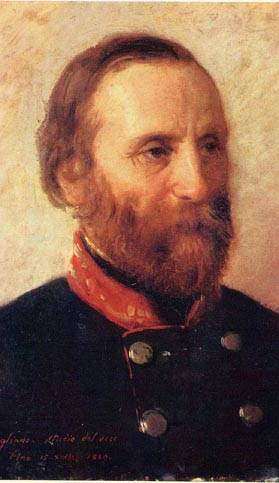 The
fall of the House of Bourbon and the Kingdom of Naples in 1860
is part of the success of the risorgimento, the movement to
unite Italy into a single nation. This success is due primarily to
three persons: a theoretician, a politician, and a soldier. The
fall of the House of Bourbon and the Kingdom of Naples in 1860
is part of the success of the risorgimento, the movement to
unite Italy into a single nation. This success is due primarily to
three persons: a theoretician, a politician, and a soldier.
The theoretician,
the ideologue, the one who preached national unity, was Giuseppe
Mazzini (1805-72). He was not a particularly practical man, and he spent
much of his life in exile, proclaiming from abroad the idea of Italian
unity as a fulfillment of destiny, one which he apparently saw as a
nebulous combination of ancient Italian glory and reasonable aspirations
to modern nation-statehood.
The politician
of the risorgimento, a person as shrewd as Metternich and Bismark,
was Camillo Benzo Conte di Cavour (1810-61) the prime minister of the
Kingdom of Piedmont. Northern Italy in the mid-1800s was a patchwork.
There was Piedmont, Lombardy, Modena, Venezia, the Papal States, etc.
etc., each a sovereign state. It was Cavour who had the political acumen
to handle the problem of northern unity before turning to the greater
one of unifying north and south. He was, however, a conservative and
calculating man, one who favoured a gradual process of unification over
revolution.
The politician
Cavour might have had his way if the soldier, Giuseppe Garibaldi (1807-82),
as a young man in the 1830s, had not wandered into a tavern where the
theoretician, Mazzini, was holding forth to fellow members of the revolutionary
group, Young Italy.
| "What
do you mean by Italy?" asked one. "The Kingdom of Naples? The
Kingdom of Piedmont? The Duchy of Modena?"
"I
mean the new Italy… the united Italy of all the Italians,"
said Mazzini.
|
"At that
point," recalled Garibaldi in later years, "I felt as Columbus must
have felt when he first sighted land."
As a pirate,
patriot, soldier of fortune, lover and guerilla fighter from Italy to
South America, Garibaldi had a patent on the swashbuckle. He survived
imprisonment, torture, severe wounds and exile. As a general, he was
fearless, commanding respect and loyalty from his men by fighting
right alongside them in hand-to-hand combat. He was a man of action
with an acute sense of justice and a childlike belief that good would
triumph over immorality and corruption. He didn't want to win battles
for politicians —he distrusted them. He was simply and truly
out to smite evil. He was what most twelve-year-old boys want to be
when they grow up, and if you ever have a strange dream in which you
are beset by enemies and plagued by wrongdoers, and your dreammeister
lets you choose whomever you want for help, take Garibaldi. Ask
Cavour and Mazzini. They took him, and they didn't even like him. He
was that good.
Thus, in
May of 1860, Francis II, King of the Two Sicilies had excellent reason
to worry. Garibaldi, over the objections of the ultra-cautious Cavour,
had just smuggled a small and almost unarmed (!) group of men out of
the port of Genoa aboard two leaky tubs and set off to liberate
the Italian south. He would start in Sicily, in support of a local uprising,
and work his way over to the mainland and on up to the capital, the
city of Naples. He cajoled and threatened weapons and ammunition out
of the commanders of a few armories along the way as he plodded south
toward Sicily, where his famous "Thousand redshirts" (1,089, to
be exact) would take on a regular army twenty times that number.
The Kingdom
of the Two Sicilies had a sizable army and the largest navy in the Mediterranean.
Socially and politically, however, it had been standing still since
the post-Napoleonic Restoration in 1815, surviving the Carbonari revolution of 1820 and successfully resisting
calls for reform only by being propped up by the Austrian army and Swiss
mercenaries. Many of the kingdom's liberals and intellectuals had left,
and by 1860 even King Francis could sense what was coming. In June of
that year (after Garibaldi had already taken Sicily!) he revived
the constitution of 1848 and relinquished his absolute powers. There
was even talk of an alliance between a liberalized Naples and the Piedmont
kingdom of northern Italy—an Italian federation, of sorts. This,
indeed, would have been a watered-down risorgimento, but
it would have thwarted Garibaldi.
Even northern
politicians, primarily Cavour, while theoretically in favor of Italian
unification, were aghast at the thought of a popular revolutionary army
led by a thousand redshirted lunatics storming up the peninsula, spreading
a message of instant universal brotherhood. Garibaldi, after all,
in his youth had had to do with a mystic band of Christian communards,
the St. Simonians, who, years before Karl Marx, had preached:
From each according to his capacity: to each according to his works;
the end of the exploitation of man by man; and The abolition of all
privileges of birth.
Garibaldi
landed at Marsala and a few days later engaged a superior force
near Calatafimi. He threw caution to the winds (he didn't have very
much of it, to begin with), said, "Here we either make Italy or die",
and led a ferocious bayonet charge uphill, literally overrunning the
enemy.
And that
was more or less that. Sicilian irregulars in rebellion against the
royal forces had been watching the engagement from nearby hillsides.
They liked what they saw. Soon Garibaldi's forces were swelled by a
ragtag collection of rebels armed with guns, axes, clubs and whatever
else could kill a Bourbon. Together they marched on Palermo and by ceaseless
guerilla street fighting drove the Bourbon commander into asking for
an armistice, the only condition being that royalist forces be allowed
to leave the island for the mainland.
With 3,500
men under him, Garibaldi then crossed to the mainland and started the
300-mile slog in the heat of summer up towards Naples, his reputation
preceding him by leaps and bounds. Peasants were already calling him
the "Father of Italy," mothers brought their babies out to be
blessed by him, and there was an air of natural invincibility about
him as he moved north.
Garibaldi
at his home on the island of Caprera in Sardinia
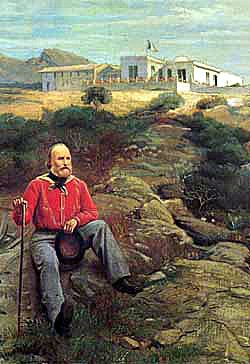 There is
much discussion even today about exactly how a relatively small band
of Garibaldini, augmented at most by a few thousand irregulars
picked up along the way, managed to make their way up the peninsula
against what, at least on paper, appeared to be an overwhelmingly superior
force. It is probably best to view Garibaldi's victory as resulting
from a combination of factors. First, Garibaldi, himself, was a master
of the hit-and-run harassing tactics that would one day become known
as "guerilla warfare." He was also a firm believer in Napoleon's dictum
that "morale is to material as ten is to one"—and his Redshirts
had morale to burn. They were the righteous bringers of a new nation,
and there is little doubt that large numbers of the long-suffering peasantry
in Calabria and Puglia (perhaps less so as he moved further north towards
Naples) genuinely viewed them as liberators. There is
much discussion even today about exactly how a relatively small band
of Garibaldini, augmented at most by a few thousand irregulars
picked up along the way, managed to make their way up the peninsula
against what, at least on paper, appeared to be an overwhelmingly superior
force. It is probably best to view Garibaldi's victory as resulting
from a combination of factors. First, Garibaldi, himself, was a master
of the hit-and-run harassing tactics that would one day become known
as "guerilla warfare." He was also a firm believer in Napoleon's dictum
that "morale is to material as ten is to one"—and his Redshirts
had morale to burn. They were the righteous bringers of a new nation,
and there is little doubt that large numbers of the long-suffering peasantry
in Calabria and Puglia (perhaps less so as he moved further north towards
Naples) genuinely viewed them as liberators.
The confused
situation in the Bourbon military also worked to Garibaldi's advantage.
There was massive desertion among royalist troops, many of whom felt
that they were now bound up in defending a lost cause. Additionally,
the officer corps had been bitterly split for at least a decade between
old-guard royalists and those who felt that the time for a united Italy
had come at last.
All this,
and more, combined to produce the unlikely sight, on September 7, 1860,
of Giuseppe Garibaldi and a small group of companions entering Naples
unopposed, by train (!) from Salerno and then in an open carriage from
the station to the Royal Palace. They were miles ahead of the
army. The king had fled to Gaeta the day before and the city and remaining
troops welcomed the Risorgimento by giving Garibaldi a hero's
welcome.
A Bourbon
force of about 20,000 troops had remained loyal to the king and
gone north with him. Initially, the king had intended his retreat as
somewhat of a strategic withdrawal. He had no intention of surrendering
his kingdom without a fight. His army, near Gaeta, was, however, also
being pressed from the north by the advancing army of King Victor Emanuel
of Piedmont, who had finally decided to get on the bandwagon of unification
before Garibaldi got all the credit. Thus hemmed in, the Bourbons made
a desperate effort in early October to break out and retake their kingdom
by storming south at the Volturno River. Garibaldi was called upon for
one of the few times in his life to fight a pitched battle instead of
one of his guerilla actions, and to defend instead of attack. He commanded
troops along a twenty-kilometer front against a superior attacking force
and held.
On October
25th, near Capua, Garibaldi greeted Victor Emanuel of Piedmont's Royal
House of Savoy with the words, "Greetings to the first King of Italy"
and surrendered his conquests—Sicily, half the Italian peninsula
and the vast Neapolitan Royal Navy (considerably superior to northern
Italian fleets of the time)—without the slightest hesitation or
thought of reward for himself—simply because it was the right
thing to do.
For their
efforts, Garibaldi and his superb men were completely and utterly snubbed
by the new rulers of Italy. The egalitarian initiatives such as free
education and land reform that Garibaldi had set up during his brief
reign as "Dictator of Naples" were revoked, provoking for another
decade in much of the south what almost amounted to a civil war as recently
liberated subjects of the Bourbons took to the hills to escape their
liberators from the north.
Garibaldi
didn't like the way things had turned out, but figured it was just more
injustice he would have to straighten out when he got around to it.
He spent the last twenty years of his life actively trying to do just
that in one way or another, in one place or another. He would fight
more battles, be arrested and imprisoned (he escaped) and even be elected
to parliament. He didn't have a political bone in his body, and he continued
to be saddened and confounded by the politics of those who refused to
do the right thing. The Kingdom of Naples, which Garibaldi had handed
to Victor Emanuel on a silver platter, was officially dissolved on Oct.
22, 1860, when Neapolitans voted by plebiscite to become part of Mazzini's
"new Italy…united for all Italians".
The
last military action by the Bourbons against the armies of united Italy
was as heroic as it was useless. After the battle of Volturno, Francis
II and his faithful men and officers retreated to Gaeta, circled the
wagons and prepared to go down fighting. From November 1860, to February
1861, the city was subjected to a ferocious bombardment. Without the
slightest chance of withstanding a siege, much less ever getting their
kingdom back, and with no ulterior strategic goal, the Bourbons of Naples
resisted and fought the way brave men do who have nothing to lose. Napoleon
III of France implored them to give up, as did even the attacking Italian
commander, Bersaglieri commander Cialdini, who said that he would be
honored to fight against such valiant troops if it weren't a case of
Italian against Italian.
After 8,000
of his men had fallen in the siege, the King told those who wanted to
leave to do so. Almost no one left. Histories of the siege are replete
with truly moving accounts of the young queen Maria Sophia on the ramparts, herself, encouraging
the defenders and refusing to eat so that her food could be given to
the wounded. Apparently, when honour had been satisfied, for one can
think of no other reason, Francis agreed to surrender. He and his wife
went to Rome as guests of the Pope. When the Papal State fell in 1870,
they settled in Paris. He died in 1894, his wife in 1925.
The Bourbon
dynasty was the high point as well as the end of the existence of southern
Italy as a separate nation. Today, 140 years after the irresistible
Risorgimento (bearing in mind, of course, that judgements about
"irresistible" are always easier after the fact) forcibly incorporated
The Kingdom of Naples into greater Italy, it is still difficult to draw
dispassionate conclusions that balance the former existence of the South
as a separate and respected European state against the subsequent advantages
as part of a single greater nation.
There
is a good 19th-century political cartoon plus accompanying article from
Harper's Weekly about Garibaldi's conquering of the Kingdom of Naples
at
http://www.nytimes.com/learning/general/onthisday/harp/0707.php
Immigration
(4)
The terms
“multicultural” and “multiethnic” present a
certain paradox when thinking about Naples. At times, looking at the
long history of the city, it seems that it must have always been a grand
mixture of different peoples. When the Spanish first got here in the
1500s, for example, Spanish soldiers, officers, diplomats, and merchants
suddenly occupied most of the area near the Royal Palace. That is the
area still known as “The Spanish Quarter”. Of course, there
are no Spanish there, any more. Whatever was separately and distinctly
Spanish about the area is now totally Neapolitan. Taking that which
is foreign and making it your own is very characteristic of Naples.
The Spanish experience has surely been repeated many times over the
centuries. Naples seems to be a giant blender that homogenizes whatever
might start out to be separate and distinct elements in society. Thus,
it is, yes, multicultural, but then very quickly Neapolitan.
The Naples
daily, il Mattino, uses the term “multicolor” to
describe the relatively new phenomenon of immigrant children in Naples
attending local public schools. Naples has never been a racist culture,
so the journalist uses such terms quite innocently. She is merely describing
what for her is new and fascinating when she writes about a little girl
as “three–and–a–half years old, a tiny thing
with grand eyes, wearing a rose-colored checkered school blouse that
contrasts with her coal–black skin.”
The Neapolitan
public school system is now dealing with the fact that Naples, for whatever
reason, is home to thousands of immigrants. They may be newly arrived
refugees from eastern Europe, au pair from almost anywhere in the world,
African street vendors, or Rom—gypsies.
Children
of these persons are required to attend school. Last year, 2,825 immigrant
children registered for elementary schools in the Campania province,
of which Naples is the capital. The trend seems to be about a 20% increase
per year. More than half, 1650, were registered for elementary schools
in the city of Naples, itself. Caserta had 750 and Salerno 200. One
particular school in Naples actually qualifies for a special state subsidy
since more than 10% of the student body is immigrant. “So far,”
says the principal, “we haven’t seen a cent.”
The consensus
among teachers is that there are no problems having to do with a pupil
being of a different race. (That is gratifying, but I would have predicted
that.) There are the same language problems, especially with older students
(say, above the age of 12) that you find almost anywhere in the world
in schools where children are suddenly required to learn a new language.
Socially, there is some problem in getting parents in particularly intransigent
immigrant groups such as gypsies to send their children to local schools
in the first place. Volunteers regularly go out into the community to
try to convince these parents to do what is best for their children.
Blackout,
rainfall
Of
natural and manmade catastrophe
About two
weeks ago, Naples had its worst rainfall in living memory. The report
was of a downpour at the rate of four inches an hour. That didn’t
keep up for an hour, but for the 15 or 20 minutes that rain fell like
that, it was impressive, indeed. The rain then eased off to a solid
one inch an hour for much of the day.
Rain like
that—or anything even remotely like that—always causes problems
in Naples. There are two main concerns: one is that the city sewers
can’t handle the run-off. As a result, streets are flooded. Indeed,
down at sea level at the small port of Mergellina, streets were turned
into lakes as a result of rain water flowing downhill from the Posillipo
hill directly above the harbor. The second concern is for the structural
integrity of the subsoil. The large hill that much of the city rests
on is honeycombed with natural and manmade caverns (mostly manmade,
from centuries of quarrying). Every time it rains heavily, some piece
of the city, somewhere, is almost guaranteed to cave in.
The rain
caused some damage to the San Carlo Theater. The drainpipes that are
supposed to get water off the roof of the theater—even when they
are in perfect, unclogged condition (apparently they weren’t)—couldn’t
begin to cope with that amount of water. The damage seems to be minor,
limited at first appraisal to some minor staining of the fresco by Cammarano
on the great ceiling of the theater. The water had to flow somewhere,
so it seeped into the cracks on the roof and found its way through to
the ceiling.
The big
disaster, of course—and this happened just yesterday—is
totally manmade. Well, it was apparently caused by someone or something
in Switzerland. Maybe a cow backed into an Automatic Teller and Milking
Machine (conveniently situated in every pasture in the country for all
your financial and dairy needs) and set off some sort of a Rube Goldberg
chain-reaction. In any event, all of Italy was blacked out for almost
an entire day. Much worse than the great loss to the economy was the
general feeling of disappointment on the part of many Italians at no
longer being able to laugh up their sleeves at the electrotechnologically
backward United States for that blackout a few weeks ago in the northeast.
The only
place in Italy that was unaffected was the delightfully self-sufficient
island of Sardinia, where I happen to be at the moment. I am very happy
not to have been in Naples during a major blackout. It happened at 3
o’clock in the morning, so there weren’t that many people
trapped in elevators. (What were they doing up at that hour?) Fortunately,
the metropolitana—the subway train line—doesn’t run
all night.
I have
never been trapped in the elevator in my apartment house. Now, if my
wife or any other Neapolitan actually knew that I had just written that
sentence, they would go through a series of ritual movements and oaths
to pacify the power that I have just challenged. I have evoked the possibility—nay,
the certainty—just by mentioning it. I don’t believe in
all that, so I say, go ahead, Elevator God, take your best shot.
Santa
Chiara, church (2)
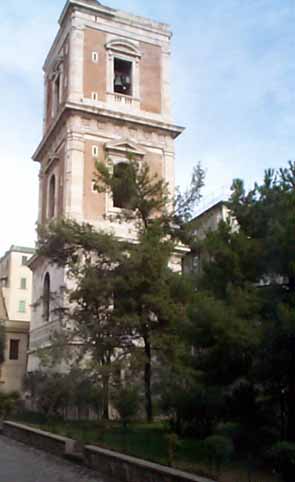 A ceremony was held in the city hall the other day in
memory of (1) the destruction of the church
of Santa Chiara in 1943 and (2) the rebuilding of that church, completed
over ten years later. That rebuilding is responsible for the odd feeling
you get when you stand in the courtyard and stare at the plain masonry
and stark, Gothic architecture of the church: Santa Chiara seems at
once as old as it is and, yet, much newer. It is both. A ceremony was held in the city hall the other day in
memory of (1) the destruction of the church
of Santa Chiara in 1943 and (2) the rebuilding of that church, completed
over ten years later. That rebuilding is responsible for the odd feeling
you get when you stand in the courtyard and stare at the plain masonry
and stark, Gothic architecture of the church: Santa Chiara seems at
once as old as it is and, yet, much newer. It is both.
On August
4, 1943, after 95 previous air raids on the city of Naples aimed primarily
at military installations near the port and train station, the next
attack accidentally hit the church and, as they say here, “destroyed
six centuries in ten seconds.” (Robert of Anjou built the original
church in 1310.) The fire burned for 10 days; 159 persons were killed
and 228 were wounded. The church was left a burned-out shell. The belfry
on the grounds (photo, left) is the only part that escaped destruction.
A plaque (photo, below) on the front of the church, itself, commemorates
the reconstruction, finished in 1953.
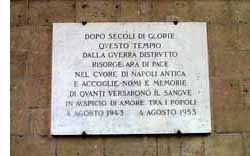
The
mayor of Naples attended the ceremony in the presence of young Franciscan
monks, born many years after the event. The ceremony was a tribute to
the reconstruction and, as well, to Brother Gaudenzio Dell’Aia,
the monk who planned and supervised the work. The church was restored
to its original Gothic state, undoing the architectural additions of
those who came after the Angevins in the history of Naples. Luigi Ortaglio,
the Franciscan who succeeded Dell’Aia as the head of the order
in Naples, spoke at the ceremony and called the reconstruction a symbol
of the “victory of peace over war” and compared it to resurrection,
the rebirth that follows death.
The plaque (photo) reads: After centuries of glory this
temple destroyed by war rises as an altar of peace in the heart of ancient
Naples and welcomes the names and memory of those who shed blood in
the hope of love among nations.
August 4, 1943 August 4, 1953
back to subject index
back
to napoli.com
|
